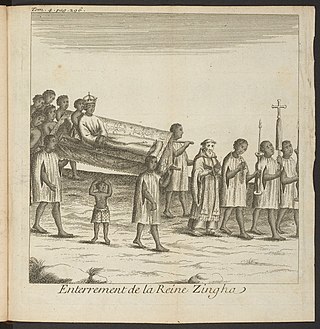
Angola, officially the Republic of Angola, is a country located on the west-central coast of Southern Africa. It is the second-largest Lusophone (Portuguese-speaking) country in both total area and population, and is the seventh-largest country in Africa. It is bordered by Namibia to the south, the Democratic Republic of the Congo to the north, Zambia to the east, and the Atlantic Ocean to the west. Angola has an exclave province, the province of Cabinda, that borders the Republic of the Congo and the Democratic Republic of the Congo. The capital and most populous city is Luanda.

Njinga Ana de Sousa Mbande was a Southwest African ruler who served as queen of the Ambundu Kingdoms of Ndongo (1624–1663) and Matamba (1631–1663), located in present-day northern Angola. Born into the ruling family of Ndongo, her father Ngola Kilombo Kia Kasenda was the king of Ndongo.

Benguela is a province of Angola, situated in the west of the country. It lies on the Atlantic Ocean, and borders the provinces of Cuanza Sul, Namibe, Huila, and Huambo. The province has an area of 39,826 square kilometres (15,377 sq mi) and its capital is Benguela. According to the 2014 census, there were 2,231,385 inhabitants in the province. The current governor of Benguela is Isaac dos Anjos.

Malanje is the capital city of Malanje Province in Angola, with a population of 455,000, and a municipality, with a population of 506,847. Projected to be the thirteenth fastest growing city on the African continent between 2020 and 2025, with a 5.17% growth. It is located 380 kilometres (240 mi) east of Angola's capital Luanda. Near it are the spectacular Calandula waterfalls, the rock formations of Pungo Andongo, and the Capanda Dam. The climate is mainly humid, with average temperatures between 20 and 24 °C and rainfall 900 to 130 millimetres in the rainy season.

Malanje is a province of Angola. It has an area of 97,602 km² and a 2014 census population of 986,363. Malanje is the provincial capital.
The Kingdom of Ndongo, 1515-1909, was an early-modern African state located in the highlands between the Lukala and Kwanza Rivers, in what is now Angola.
The Imbangala or Mbangala were divided groups of warriors and marauders who worked as hired mercenaries in 17th Century Angola and later founded the Kasanje Kingdom.

N'dalatando, formerly Vila Salazar, is a town, with a population of 161,584 (2014), and a commune in the municipality of Cazengo, province of Cuanza Norte, Angola.
The Kingdom of Matamba (1631–1744) was an African state located in what is now the Baixa de Cassange region of Malanje Province of modern-day Angola. It was a powerful kingdom that long resisted Portuguese colonisation attempts and was only integrated into Angola in the late nineteenth century.

The Ambundu or Mbundu (Mbundu: Ambundu or Akwambundu, singular: Mumbundu are a Bantu people who live on a high plateau in present-day Angola just north of the Kwanza River. The Ambundu speak Kimbundu, and most also speak the official language of the country, Portuguese. They are the second biggest ethnic group in the country and make up 25% of the total population of Angola.

Giovanni Antonio Cavazzi da Montecuccolo (1621–1678) was an Italian Capuchin missionary noted for his travels in 17th century Portuguese Angola and his lengthy account of local history and culture as well as a history of the Capuchin mission there.
The Battle of Kombi was a decisive battle in the war between Ndongo-Matamba and Portugal during the Dutch period of Angolan history.
The precolonial history of Angola lasted until Portugal annexed the territory as a colony in 1655.
The colonial history of Angola is usually considered to run from the appearance of the Portuguese under Diogo Cão in 1482 (Congo) or 1484 until the independence of Angola in November 1975. Settlement did not begin until Novais's establishment of São Paulo de Loanda (Luanda) in 1575, however, and the Portuguese government only formally incorporated Angola as a colony in 1655 or on May 12, 1886.
Lourenço da Silva Mendouça was a member of the Ndongo royal family who ruled the Kingdom of Ndongo in what is now Angola. An abolitionist, he was probably the first person to successfully convince authorities to end slavery in Europe. A Catholic, his dealings were mostly with Church authorities and those with whom they were associated.

The Black Rocks at Pungo Andongo are a set of extensive monolithic rock formations, millions of years old, that stand out for their size in relation to the savanna landscape of the region. It is subdivided into Western, South, North and Southeast subsystems. The formation is an extension of the Cacuso Plateau.
The Portuguese colony of Angola was founded in 1575 with the arrival of Paulo Dias de Novais with a hundred families of colonists and four hundred soldiers. Luanda was granted the status of city in 1605. The fortified Portuguese towns of Luanda and Benguela.
The Battle of Mbumbi was a military engagement between forces of Portuguese Angola and the Kingdom of Kongo in 1622. Although the Portuguese were victorious, the battle served as the impetus for the Kingdom of Kongo to expel the Portuguese from their territory.

The Battle of Pungo Andongo, also known as the siege of Pungo Andongo was a military engagement in what is today Angola between Portugal and the Kingdom of Ndongo whose capital, Pungo Andongo, also known as Pedras Negras, was besieged. After a nine-month encirclement, the capital was taken by storm, plundered and occupied by the Portuguese.









